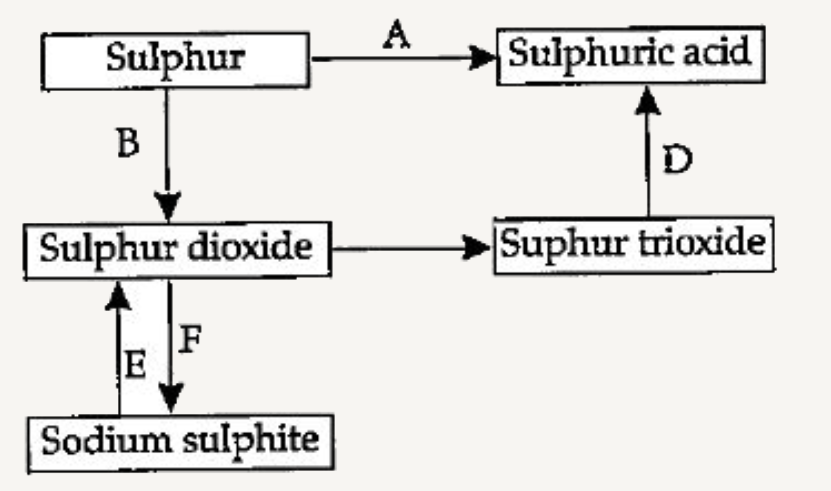Give balance equations for -i. A direct combination reaction involving two elements, one of which is a non metal ii. A thermal decomposition reaction involving heat on limestone [calcium carbonate] iii. An electrolytic decombosition reaction involving a neutral liquid iv. A displacement reaction involving a metal above hydrogen in the activity series with copper [II] sulphate solution v. A double decomposition neutralization reaction involving an acid & a base vi. A white precipitate obtained during a double decomposition reaction involving a silver salt with a sodium salt.
Step-by-Step Text Solution:
1. Direct Combination Reaction Involving Two Elements (One Non-Metal):
- Example: Sodium (Na) and Oxygen (O)
- Unbalanced Equation:
Na+O2→Na2O
- Balancing:
- There are 2 oxygen atoms on the left, so we need 2 sodium atoms to balance it.
- The balanced equation is:
4Na+O2→2Na2O
2. Thermal Decomposition Reaction Involving Heat on Limestone (Calcium Carbonate):
- Example: Calcium Carbonate (CaCO₃)
- Unbalanced Equation:
CaCO3→CaO+CO2
- Balancing:
- The equation is already balanced as there is one calcium, one carbon, and three oxygens on both sides.
- The balanced equation is:
CaCO3→CaO+CO2
3. Electrolytic Decomposition Reaction Involving a Neutral Liquid:
- Example: Water (H₂O)
- Unbalanced Equation:
H2O→H2+O2
- Balancing:
- To balance the equation, we need 2 water molecules to produce 2 hydrogen and 1 oxygen molecule.
- The balanced equation is:
2H2O→2H2+O2
4. Displacement Reaction Involving a Metal Above Hydrogen in the Activity Series with Copper(II) Sulfate Solution:
- Example: Zinc (Zn) with Copper(II) Sulfate (CuSO₄)
- Unbalanced Equation:
Zn+CuSO4→ZnSO4+Cu
- Balancing:
- The equation is already balanced as there is one zinc, one copper, one sulfate on both sides.
- The balanced equation is:
Zn+CuSO4→ZnSO4+Cu
5. Double Decomposition Neutralization Reaction Involving an Acid & a Base:
- Example: Sulfuric Acid (H₂SO₄) and Sodium Hydroxide (NaOH)
- Unbalanced Equation:
H2SO4+NaOH→Na2SO4+H2O
- Balancing:
- We need 2 NaOH to balance the sodium and hydrogen.
- The balanced equation is:
H2SO4+2NaOH→Na2SO4+2H2O
6. White Precipitate Obtained During a Double Decomposition Reaction Involving a Silver Salt with a Sodium Salt:
- Example: Silver Nitrate (AgNO₃) and Sodium Chloride (NaCl)
- Unbalanced Equation:
AgNO3+NaCl→AgCl+NaNO3
- Balancing:
- The equation is already balanced as there is one silver, one sodium, one nitrate, and one chloride on both sides.
- The balanced equation is:
AgNO3+NaCl→AgCl+NaNO3
- Example: Sodium (Na) and Oxygen (O)
- Unbalanced Equation:
Na+O2→Na2O
- Balancing:
- There are 2 oxygen atoms on the left, so we need 2 sodium atoms to balance it.
- The balanced equation is:
4Na+O2→2Na2O
- Example: Calcium Carbonate (CaCO₃)
- Unbalanced Equation:
CaCO3→CaO+CO2
- Balancing:
- The equation is already balanced as there is one calcium, one carbon, and three oxygens on both sides.
- The balanced equation is:
CaCO3→CaO+CO2
- Example: Water (H₂O)
- Unbalanced Equation:
H2O→H2+O2
- Balancing:
- To balance the equation, we need 2 water molecules to produce 2 hydrogen and 1 oxygen molecule.
- The balanced equation is:
2H2O→2H2+O2
- Example: Zinc (Zn) with Copper(II) Sulfate (CuSO₄)
- Unbalanced Equation:
Zn+CuSO4→ZnSO4+Cu
- Balancing:
- The equation is already balanced as there is one zinc, one copper, one sulfate on both sides.
- The balanced equation is:
Zn+CuSO4→ZnSO4+Cu
- Example: Sulfuric Acid (H₂SO₄) and Sodium Hydroxide (NaOH)
- Unbalanced Equation:
H2SO4+NaOH→Na2SO4+H2O
- Balancing:
- We need 2 NaOH to balance the sodium and hydrogen.
- The balanced equation is:
H2SO4+2NaOH→Na2SO4+2H2O
- Example: Silver Nitrate (AgNO₃) and Sodium Chloride (NaCl)
- Unbalanced Equation:
AgNO3+NaCl→AgCl+NaNO3
- Balancing:
- The equation is already balanced as there is one silver, one sodium, one nitrate, and one chloride on both sides.
- The balanced equation is:
AgNO3+NaCl→AgCl+NaNO3
Similar Questions
Knowledge Check
All reactions involving chemical decomposition are
AreversibleBreversible and endothermicCexothermicDmay be reversible or irreversible and endothermic or exothermicEster formation involves the reaction of
Aan aldehyde and a ketoneBan alcohol with RMgXCtwo molecules of an acid with dehydrating agentDan acyl halide with an alcohol.Ester formation involves the reaction of
Aan aldehyde and a ketoneBan alcohol with RMgXCtwo molecules of an acid with dehydrating agentDan acyl halide with an alcohol.
Reaction involving syn addition is
View SolutionA reaction involving two different reactants can never be:
View Solution
What is the reaction involved in B?
View SolutionGive a balanced equation for each of the following types of reaction:
A displacement reaction in which a metal above hydrogen in the reactivity series, displaces another metal from the solution of its compound.
View SolutionEster formation involves the reaction of
View Solution